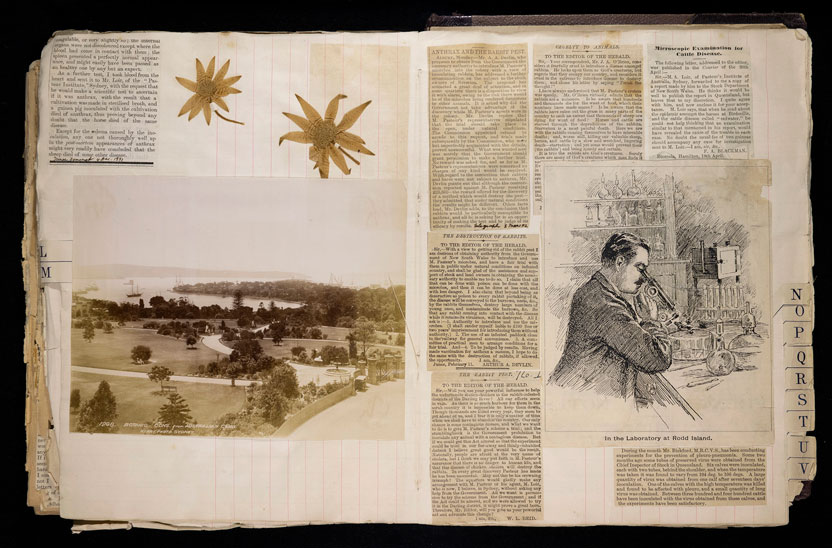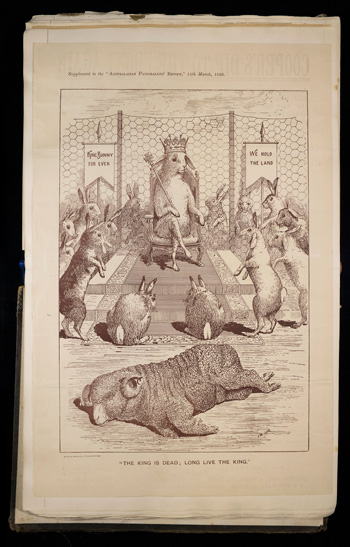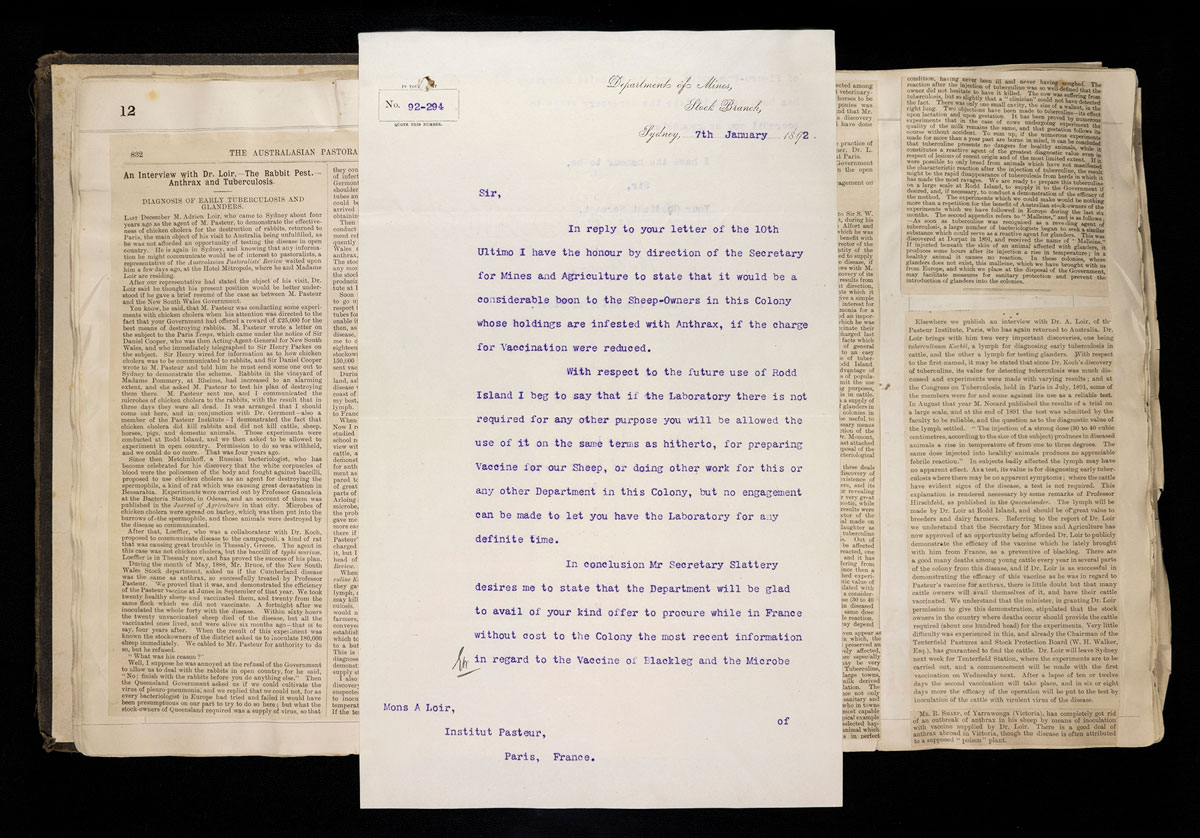
The Australian Academy of Science’s unique collection of manuscripts describes a strange chapter in scientific history, one that has to do with rabbits, livestock disease and a $10 million reward. To improve access to the collection, the Academy recently published a digital version of the fascinating scrapbooks belonging to a young Adrien Loir, nephew and protégé of famed microbiologist Louis Pasteur.
The spread of rabbits in mainland Australia began in 1859, when 24 wild-caught rabbits from England were released on the Winchelsea estate of Thomas Austin for a touch of home and a ‘spot of hunting.’ They multiplied at an astonishing speed and by 1880 had become a plague of almost one billion. The rabbits overran vast areas of the countryside, and the Australian pastoral industry was facing collapse.
By 1887 it was clear the rabbits would resist all attempts to control their numbers. The increasingly desperate New South Wales government of Sir Henry Parkes appointed an Intercolonial Rabbit Commission to find a biological solution to the problem. The commission sent out a global call for ideas and offered a massive reward – £25,000 or $10 million in today’s terms – for ‘any method or process not previously known in the colony for the effectual extermination of rabbits.’
The prize drew the attention of Dr Louis Pasteur, the renowned French scientist whose work showed that microorganisms cause disease at a time when the validity of germ theory was still being questioned. Pasteur pioneered the first vaccines for chicken cholera, anthrax, and the much-feared rabies. At the time of the Australasian Rabbit Competition, however, he was recovering from his second stroke and struggling for funds to open his Institut Pasteur in Paris.
Pasteur saw the prize as an opportunity. His past experiments had demonstrated that chicken cholera (now called fowl cholera) was fatal to rabbits and worked to control their numbers when trialled northeast of Paris. Pasteur was convinced he had the solution and dispatched his nephew Adrien Loir and two colleagues, Dr François Germont and Dr Frank Hinds, to Australia to prove it and claim the reward.
The Pasteur team – headed by Adrien Loir – arrived in Australia in 1888, expecting to prove their remedy and return home with the prize money. They encountered resistance almost immediately. No one was enthusiastic about importing a new disease into the country and many on the Rabbit Commission had agendas of their own. One delegate had secret orders from the Premier of Queensland to divert Pasteur’s focus from rabbits to cattle diseases, two others imported rabbit-proof fencing wire, one was the president of a poultry farmers association justifiably fearful of chicken cholera, and another two were former students of Pasteur’s great rival, German scientist Dr Robert Koch.
Loir was almost refused entry into New South Wales, but the Commission eventually relented and constructed a laboratory on tiny Rodd Island, at the edge of Sydney Harbour, for the team to conduct their experiments and prove their rabbit eradication method.
Months after the Pasteur team landed in Australia, they performed their six weeks of pre-planned experiments, and the Rabbit Commission began deliberating a decision. The terms of the competition insisted on a year’s worth of trials, and Loir remained in Australia to wait. He turned his attention to the mysterious Cumberland disease that was devastating Australia’s sheep and cattle industry.

The Rabbit Commission eventually determined that while chicken cholera killed rabbits, it was not sufficiently transmissible to make a dent in their numbers. Equally troubling was that the disease appeared fatal to all birds. An annoyed Louis Pasteur would have noted that according to the very vague terms of the competition, he should still qualify for the reward. The NSW government had stated that a remedy to the rabbit problem could not be ‘noxious to horses, sheep, camels, goats, swine, or dogs’ but had neglected any mention of birds.
This argument did not sway the Australians. Nobody won the £25,000 prize, but by 1889 it hardly mattered. Adrien Loir’s diversion into livestock diseases paid off. He and François Germont determined that Cumberland disease was, in fact, anthrax. As Pasteur already had a working anthrax vaccine, they persuaded the Parkes government to support a public vaccine trial that was so successful it seemed miraculous to those gathered to observe. Loir also worked with a grateful Queensland government to develop vaccines for the bovine pleuropneumonia and blackleg diseases plaguing the cattle industry in the colony.
Loir made considerable profits manufacturing vaccines on Rodd Island over the next four years, more than the original prize for the rabbit competition. Pasteur combined these funds with donations raised by a French newspaper campaign and proceeded with his Paris Institute.
Adrien Loir was a collector. While in Australia he kept two massive scrapbooks containing pressed flowers and steamship tickets alongside obscure media coverage, cartoons, letters and journal articles in French and English. He travelled between cities and rural areas, took photographs, and hinted at ongoing political controversies, including an accusation that the NSW government was interfering with his mail – which, to be fair to Loir, was true. There are press clippings touching on his relationship with visiting French actress Sarah Bernhardt and famously turbulent personal life. These small details stand out among the vast collection of memorabilia about rabbits, livestock, and his eventual transition from Australia back to France followed by his next post in Tunisia. The scrapbooks cover the period 1888 to 1894.
The Adrien Loir scrapbooks are now freely accessible via the Academy online catalogue.
Australia had to wait another 60 years for an effective response to the rabbit problem. The myxoma virus was released in 1950 after years of pioneering research by Professor Frank Fenner, a foundation Fellow of the Academy, and his colleagues. The population dropped by half a billion in the first two years, and while rabbits remain a problem, they have never recovered their plague era numbers.

The Academy would like to thank philanthropist David Anstice whose support made digitisation of the Adrien Loir collection possible.
The research and experience of Australian scientists forms the foundation on which we build our future. It is vital that we capture and preserve their stories. Donations from organisations and individuals are welcome; if you would like more information about supporting the archive project, please contact our Philanthropy Manager at philanthropy@science.org.au
© 2025 Australian Academy of Science